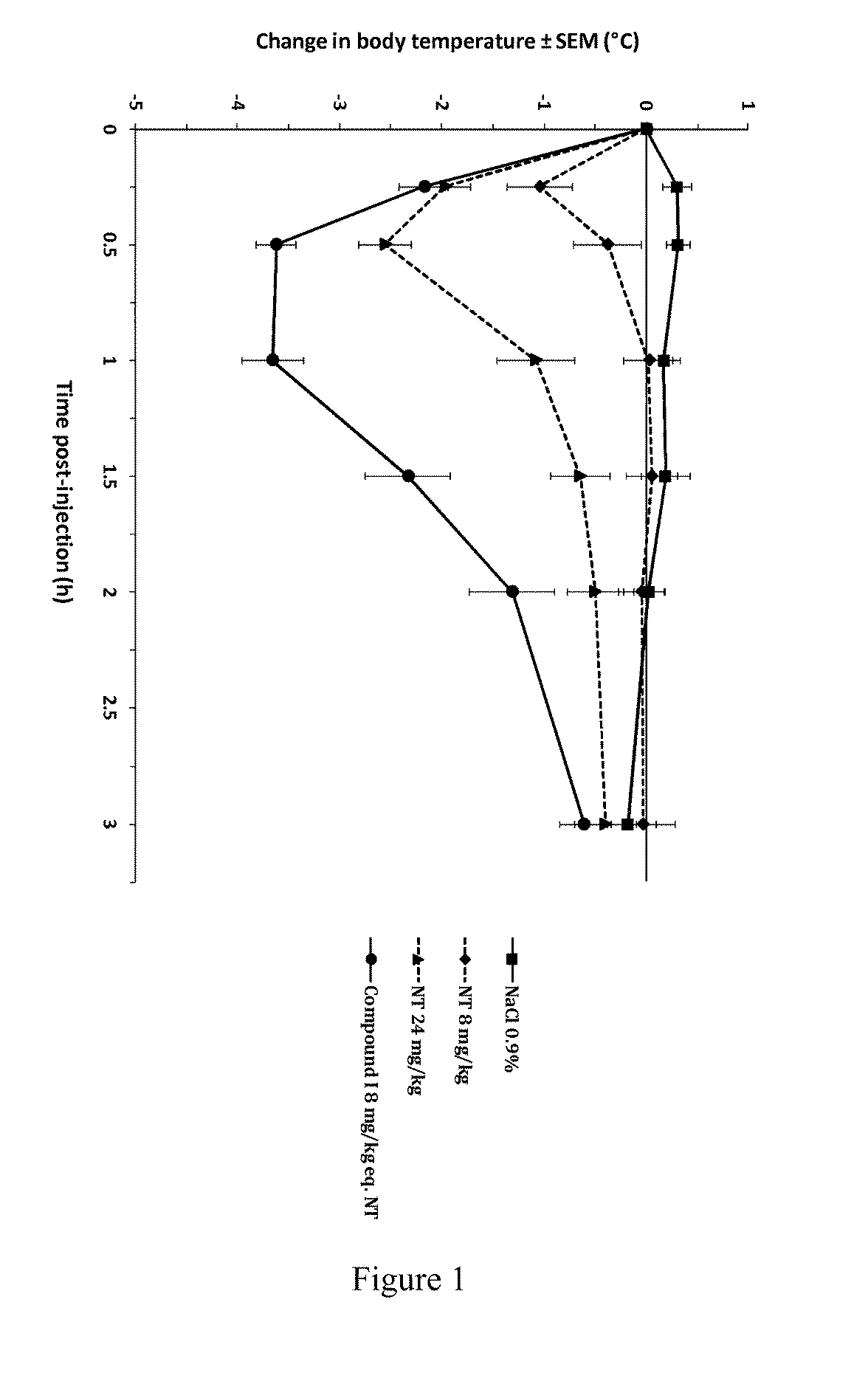Activated neurotensin molecules and the uses thereof
a neurotensin and activation technology, applied in the field of activation neurotensin molecules, can solve the problems of delayed onset of action and/or transient effect, rapid proteolytic cleavage in plasma, and difficult implementation
- Summary
- Abstract
- Description
- Claims
- Application Information
AI Technical Summary
Benefits of technology
Problems solved by technology
Method used
Image
Examples
example 1
Synthesis of Activated NT(1-13)-AG Drugs Via NT-Lys6
[0112]In a first step, full-size neurotensin pELYENKPRRPYIL-OH (NT) was coupled to various activator groups (AGs) developed by the inventors. The objective was to select the best AG / NT combinations. To synthesize such molecules we took advantage of the amine reactivity of the lysine 6 side chain in the neurotensin sequence. Commercial sulfo-EMCS (N-epsilon-Maleimidocaproyl-oxysulfosuccinimide ester) was coupled via its succinimide ester moiety on lysine 6. After purification functionalized neurotensin (NT-EMCS) was conjugated to the different thiolated AGs.
[0113]Three steps were therefore performed to achieve the final desired conjugates: synthesis of the two functionalized moieties, NT-EMCS and the thiolated AGs, and the coupling thereof. These steps are schematically represented below:
[0114]
Analytical and Purification Methods:[0115]Reaction progress and purity monitoring were carried out on a Dionex UltiMate® 3000 system equipped...
example 2
In Vitro Binding Affinity of Activated NT Drugs of the Invention
[0132]The central hypothermic effects of neurotensin are mediated through activation of the NTR-1 receptor. In order to elicit biological activity such as hypothermic activity, neurotensin conjugates should bind the NTR-1 with at least a similar affinity to that of native neurotensin, namely NT(1-13).
[0133]The binding affinity of the neurotensin conjugates was assessed using a competition binding assay with both human and rat neurotensin receptor type 1 (hNTR-1, rNTR-1). The cell membranes enriched for the hNTR-1 were purchased from PerkinElmer. Rat NTR-1 was obtained by transfecting HEK293 cells with a rat NTSR1 plasmid construct (Origene, Rockville, USA).
[0134]The binding affinity of activated NT drugs on hNTR-1 was performed according to the manufacturer's instructions (PerkinElmer) with slight modifications. In detail, NTR-1 binding was measured using membrane homogenates, prepared from CHO cells stably expressing h...
example 3
In Vivo Evaluation of Activated NT Drugs of the Invention
[0139]The beneficial effect of the activated NT drugs of the invention on the central pharmacological activity of neurotensin was investigated by monitoring the hypothermic response in Swiss (CD-1) mice (FIG. 1). Following intravenous (bolus) administration of NT at 8 mg / kg, mice showed a minor but significant decrease in rectal body temperature, with a maximal effect of −1° C. from baseline at 15 min post-injection. This effect increased at 24 mg / kg, reaching a maximal effect of −2.6° C. at 30 min post-injection. By contrast, intravenous administration of compound I, an activated NT drug of the invention comprising SEQ ID NO: 8 as an activator group, at the molar equivalent dose of 8 mg / kg (8 mg / kg eq. NT) induced a rapid and stronger decrease in body temperature, significant as of 15 min post-injection and reaching a maximal effect of −3.7° C. between 30 and 60 min post-injection. This pharmacological hypothermia progressive...
PUM
| Property | Measurement | Unit |
|---|---|---|
| rectal temperature | aaaaa | aaaaa |
| concentration | aaaaa | aaaaa |
| pH | aaaaa | aaaaa |
Abstract
Description
Claims
Application Information
 Login to View More
Login to View More - R&D
- Intellectual Property
- Life Sciences
- Materials
- Tech Scout
- Unparalleled Data Quality
- Higher Quality Content
- 60% Fewer Hallucinations
Browse by: Latest US Patents, China's latest patents, Technical Efficacy Thesaurus, Application Domain, Technology Topic, Popular Technical Reports.
© 2025 PatSnap. All rights reserved.Legal|Privacy policy|Modern Slavery Act Transparency Statement|Sitemap|About US| Contact US: help@patsnap.com



